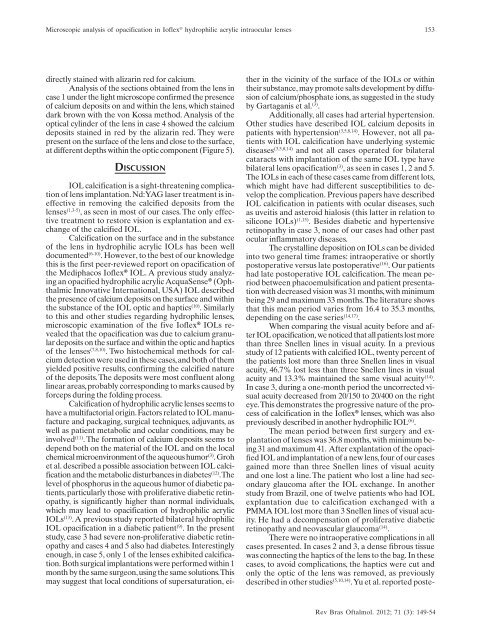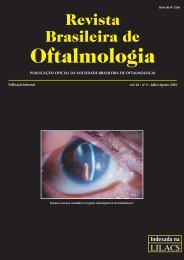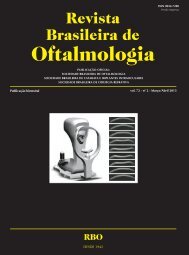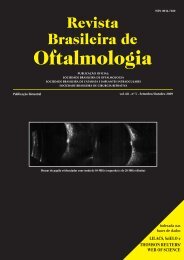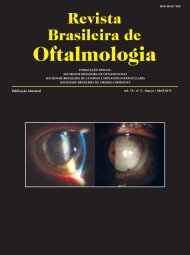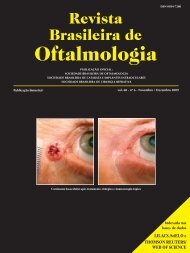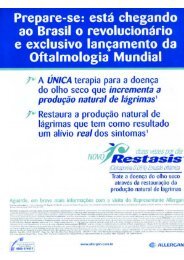Microscopic analysis of opacification in Ioflex ® hydrophilic acrylic intraocular lenses153directly stained with alizarin red for calcium.Analysis of the sections obtained from the lens incase 1 un<strong>de</strong>r the light microscope confirmed the presenceof calcium <strong>de</strong>posits on and within the lens, which staineddark brown with the von Kossa method. Analysis of theoptical cylin<strong>de</strong>r of the lens in case 4 showed the calcium<strong>de</strong>posits stained in red by the alizarin red. They werepresent on the surface of the lens and close to the surface,at different <strong>de</strong>pths within the optic component (Figure 5).DISCUSSIONIOL calcification is a sight-threatening complicationof lens implantation. Nd:YAG laser treatment is ineffectivein removing the calcified <strong>de</strong>posits from thelenses (1,3-5) , as seen in most of our cases. The only effectivetreatment to restore vision is explantation and exchangeof the calcified IOL.Calcification on the surface and in the substanceof the lens in hydrophilic acrylic IOLs has been welldocumented (6-10) . However, to the best of our knowledgethis is the first peer-reviewed report on opacification ofthe Mediphacos Ioflex ® IOL. A previous study analyzingan opacified hydrophilic acrylic AcquaSense ® (OphthalmicInnovative International, USA) IOL <strong>de</strong>scribedthe presence of calcium <strong>de</strong>posits on the surface and withinthe substance of the IOL optic and haptics (10) . Similarlyto this and other studies regarding hydrophilic lenses,microscopic examination of the five Ioflex ® IOLs revealedthat the opacification was due to calcium granular<strong>de</strong>posits on the surface and within the optic and hapticsof the lenses (7,8,10) . Two histochemical methods for calcium<strong>de</strong>tection were used in these cases, and both of themyiel<strong>de</strong>d positive results, confirming the calcified natureof the <strong>de</strong>posits. The <strong>de</strong>posits were most confluent alonglinear areas, probably corresponding to marks caused byforceps during the folding process.Calcification of hydrophilic acrylic lenses seems tohave a multifactorial origin. Factors related to IOL manufactureand packaging, surgical techniques, adjuvants, aswell as patient metabolic and ocular conditions, may beinvolved (11) . The formation of calcium <strong>de</strong>posits seems to<strong>de</strong>pend both on the material of the IOL and on the localchemical microenvironment of the aqueous humor (3) . Grohet al. <strong>de</strong>scribed a possible association between IOL calcificationand the metabolic disturbances in diabetes (12) . Thelevel of phosphorus in the aqueous humor of diabetic patients,particularly those with proliferative diabetic retinopathy,is significantly higher than normal individuals,which may lead to opacification of hydrophilic acrylicIOLs (13) . A previous study reported bilateral hydrophilicIOL opacification in a diabetic patient (9) . In the presentstudy, case 3 had severe non-proliferative diabetic retinopathyand cases 4 and 5 also had diabetes. Interestinglyenough, in case 5, only 1 of the lenses exhibited calcification.Both surgical implantations were performed within 1month by the same surgeon, using the same solutions. Thismay suggest that local conditions of supersaturation, eitherin the vicinity of the surface of the IOLs or withintheir substance, may promote salts <strong>de</strong>velopment by diffusionof calcium/phosphate ions, as suggested in the studyby Gartaganis et al. (3) .Additionally, all cases had arterial hypertension.Other studies have <strong>de</strong>scribed IOL calcium <strong>de</strong>posits inpatients with hypertension (3,5,8,14) . However, not all patientswith IOL calcification have un<strong>de</strong>rlying systemicdiseases (3,5,8,14) and not all cases operated for bilateralcataracts with implantation of the same IOL type havebilateral lens opacification (3) , as seen in cases 1, 2 and 5.The IOLs in each of these cases came from different lots,which might have had different susceptibilities to <strong>de</strong>velopthe complication. Previous papers have <strong>de</strong>scribedIOL calcification in patients with ocular diseases, suchas uveitis and asteroid hialosis (this latter in relation tosilicone IOLs) (1,15) . Besi<strong>de</strong>s diabetic and hypertensiveretinopathy in case 3, none of our cases had other pastocular inflammatory diseases.The crystalline <strong>de</strong>position on IOLs can be divi<strong>de</strong>dinto two general time frames: intraoperative or shortlypostoperative versus late postoperative (16) . Our patientshad late postoperative IOL calcification. The mean periodbetween phacoemulsification and patient presentationwith <strong>de</strong>creased vision was 31 months, with minimumbeing 29 and maximum 33 months. The literature showsthat this mean period varies from 16.4 to 35.3 months,<strong>de</strong>pending on the case series (14,17) .When comparing the visual acuity before and afterIOL opacification, we noticed that all patients lost morethan three Snellen lines in visual acuity. In a previousstudy of 12 patients with calcified IOL, twenty percent ofthe patients lost more than three Snellen lines in visualacuity, 46.7% lost less than three Snellen lines in visualacuity and 13.3% maintained the same visual acuity (14) .In case 3, during a one-month period the uncorrected visualacuity <strong>de</strong>creased from 20/150 to 20/400 on the righteye. This <strong>de</strong>monstrates the progressive nature of the processof calcification in the Ioflex ® lenses, which was alsopreviously <strong>de</strong>scribed in another hydrophilic IOL (6) .The mean period between first surgery and explantationof lenses was 36.8 months, with minimum being31 and maximum 41. After explantation of the opacifiedIOL and implantation of a new lens, four of our casesgained more than three Snellen lines of visual acuityand one lost a line. The patient who lost a line had secondaryglaucoma after the IOL exchange. In anotherstudy from Brazil, one of twelve patients who had IOLexplantation due to calcification exchanged with aPMMA IOL lost more than 3 Snellen lines of visual acuity.He had a <strong>de</strong>compensation of proliferative diabeticretinopathy and neovascular glaucoma (14) .There were no intraoperative complications in allcases presented. In cases 2 and 3, a <strong>de</strong>nse fibrous tissuewas connecting the haptics of the lens to the bag. In thesecases, to avoid complications, the haptics were cut andonly the optic of the lens was removed, as previously<strong>de</strong>scribed in other studies (5,10,14) . Yu et al. reported poste-Rev Bras Oftalmol. 2012; 71 (3): 149-54
154Ventura BV, Ventura M, Lira W, Ventura CV, Santhiago MR, Werner Lrior capsule rupture and zonule <strong>de</strong>hiscence during explantationof opacified IOLs, which were a<strong>de</strong>quatelymanaged, not affecting visual recovery (5) .In the postoperative period of the opacified IOLexplantation one of our cases had a secondary glaucoma,with an increase in IOP that was only controlled with atrabeculectomy. This patient’s second IOL was placed inthe sulcus. Former studies have <strong>de</strong>scribed other postoperativecomplications, such as posterior capsule opacification,cystoid macular e<strong>de</strong>ma, retinal <strong>de</strong>tachment, choroidalhemorrhage and endophthalmitis (4,5,14) .Although hydrophilic acrylic IOLs have higheruveal biocompatibility resulting in less postoperativeinflammation than other IOLs (18) , potential complicationssuch as late opacification have to be consi<strong>de</strong>red. From2006 to 2007, we placed approximately 4,000 Ioflex ®lenses. To date, opacification occurred in only five cases.On may 10, 2011, Mediphacos sent a report tothe Brazilian Society of Laser and Surgery in Ophthalmology(http://www.bloss.com.br/site/<strong>de</strong>fault.aspx)summarizing their investigation on the problem ofIoflex ® calcification. According to the manufacturer,they started receiving sporadic and isolated reportson Ioflex ® opacification starting in 2009, related tosome lots distributed between 2007 and 2009 (Lotsstarting with: A09, A10, B09, C09, D09, E09, F09, G08,G09, H08, H09, I08, I09, J08, J09, K08, k09, L08, L09).Surface analysis apparently confirmed the presenceof calcium/phosphate precipitation, as well as the presenceof polydimethylsiloxane (PDMS) on the surfacesof the analyzed lenses. PDMS was found to come fromthe packaging of these IOL lots, manufactured duringthe period in question. A study by Guan et al. has already<strong>de</strong>monstrated a possible role of silicone compoundsinteracting with long-chain saturated fatty acidspresent in the aqueous humor (myristic, palmitic,stearic, arachidic, and behenic) on the calcificationprocess of the Hydroview IOL (19) .Mediphacos withdrew the lenses from these lots fromthe market and the packaging was changed. However, theopacified lenses from our patients are from different lots.Thus, the presence of PDMS in the packaging of some lotsdoes not explain the lens opacification in our patients.In conclusion, this is the first report on opacificationof the Mediphacos Ioflex ® IOL <strong>de</strong>scribing microscopicfindings. The opacification of the five lenses wasdue to calcium <strong>de</strong>posits. Although this IOL should not bediscredited based on the occurrence of these calcificationcases, surgeons should be aware of this potential latepostoperative complication and further investigation onthe causes of opacification is nee<strong>de</strong>d.REFERENCES1. Neuhann IM, Kleinmann G, Apple DJ. A new classification ofcalcification of intraocular lenses. Ophthalmology.2008;115(1):73-9.2. Mamalis N, Brubaker J, Davis D, Espandar L, Werner L. Complicationsof foldable intraocular lenses requiring explantationor secondary intervention—2007 survey update. J CataractRefract Surg. 2008;34(9):1584-91.3. Gartaganis SP, Kanellopoulou DG, Mela EK, Panteli VS,Koutsoukos PG. Opacification of hydrophilic acrylic intraocularlens attributable to calcification: investigation on mechanism.Am J Ophthalmol. 2008;146(3):395-403.4. Haymore J, Zaidman G, Werner L, Mamalis N, Hamilton S,Cook J, Gillette T. Misdiagnosis of hydrophilic acrylic intraocularlens optic opacification: report of 8 cases with theMemoryLens. Ophthalmology. 2007;114(9):1689-95.5. Yu AK, Ng AS. Complications and clinical outcomes of intraocularlens exchange in patients with calcified hydrogellenses. J Cataract Refract Surg. 2002;28(7):1217-22.6. Neuhann IM, Neuhann TF, Szurman P, Koerner S, RohrbachJM, Bartz-Schmidt KU. Clinicopathological correlation of 3patterns of calcification in a hydrophilic acrylic intraocularlens. J Cataract Refract Surg. 2009;35(3):593-7.7. Walker NJ, Saldanha MJ, Sharp JA, Porooshani H, McDonaldBM, Ferguson DJ, Patel CK. Calcification of hydrophilicacrylic intraocular lenses in combined phacovitrectomy surgery.J Cataract Refract Surg. 2010;36(8):1427-31.8. Yu AK, Kwan KY, Chan DH, Fong DY. Clinical feature of 46eyes with calcified hydrogel intraocular lenses. J CataractRefract Surg. 2001;27(10):1596-606.9. Pan<strong>de</strong>y SK, Werner L, Apple DJ, Kaskaloglu M. Hydrophilicacrylic intraocular lens optic and haptics opacification in adiabetic patient: bilateral case report and clinicopathologiccorrelation. Ophthalmology. 2002;109(11):2042-51.10. Padilha MA. Complicações na cirurgia <strong>de</strong> catarata: prevençãoe manuseio. In: Padilha MA. Catarata. 2a ed. Rio <strong>de</strong> Janeiro:Cultura Médica; 2008. p. 519-42.11. Werner L. Calcification of hydrophilic acrylic intraocularlenses. Am J Ophthalmol. 2008;146(3):341-3. Comment onAm J Ophthalmol. 2008;146(3):395-403.12. Groh MJ, Schlötzer-Schrehardt U, Rummelt C, von Below H,Küchle M. [Postoperative opacification of 12 hydrogel foldablelenses (Hydroview(R)]. Klin Monbl Augenheilkd.2001;218(10):645-8. German.13. Kim CJ, Choi SK. Analysis of aqueous humor calcium andphosphate from cataract eyes with and without diabetesmellitus. Korean J Ophthalmol. 2007;21(2):90-4.14. Salera CM, Miranda RA, Reis PPL, Guimarães MR,Campolina RB, Guimarães Q. Resultados da troca <strong>de</strong> lenteintra-ocular <strong>de</strong> hidrogel opacificada. Arq Bras Oftalmol.2004;67(1):115-9.15. Stringham J, Werner L, Monson B, Theodosis R, Mamalis N.Calcification of different <strong>de</strong>signs of silicone intraocular lensesin eyes with asteroid hyalosis. Ophthalmology.2010;117(8):1486-92.16. Werner L, Apple DJ, Escobar-Gomez M, Ohrström A, CrayfordBB, Bianchi R, Pan<strong>de</strong>y SK. Postoperative <strong>de</strong>position of calciumon the surfaces of a hydrogel intraocular lens. Ophthalmology.2000;107(12):2179-85.17. Huang Y, Xie L. Delayed postoperative opacification of foldablehydrophilic acrylic intraocular lenses. J Biomed MaterRes B Appl Biomater. 2011;96(2):386-91.18. Abela-Formanek C, Amon M, Schild G, Schauersberger J,Heinze G, Kruger A. Uveal and capsular biocompatibility ofhydrophilic acrylic, hydrophobic acrylic, and silicone intraocularlenses. J Cataract Refract Surg. 2002;28(1):50-61.19. Guan X, Tang R, Nancollas GH. The potential calcification ofoctacalcium phosphate on intraocular lens surfaces. J BiomedMater Res A. 2004;71(3):488-96.Correspon<strong>de</strong>nce address:Bruna V. VenturaAltino Ventura Foundation – FAVRua do Progresso, nº 71 – Boa VistaZip Co<strong>de</strong>: 50070-020 - Recife (PE), BrazilPhone: 55 81 3302-4343E-mail: brunaventuramd@gmail.comRev Bras Oftalmol. 2012; 71 (3): 149-54
- Page 1 and 2: vol. 71 - nº 3 - Maio/Junho 2012RB
- Page 3 and 4: 144Revista Brasileira de Oftalmolog
- Page 5 and 6: 146173 Características e deficiên
- Page 7 and 8: 148Rezende F, Bisol RAR, Tiago Biso
- Page 9 and 10: 150Ventura BV, Ventura M, Lira W, V
- Page 11: 152Ventura BV, Ventura M, Lira W, V
- Page 15 and 16: 156Moura EM, Volpini M, Moura GAGIN
- Page 17 and 18: 158Moura EM, Volpini M, Moura GAGco
- Page 19 and 20: 160ARTIGO ORIGINALEficácia da comb
- Page 21 and 22: 162Almodin J, Buhler Junior C, Almo
- Page 23 and 24: 164ARTIGO ORIGINALHipermetropia ap
- Page 25 and 26: 166Ambrósio Jr R, Silva RS; Lopes
- Page 27 and 28: 168Ambrósio Jr R, Silva RS; Lopes
- Page 29 and 30: 170Ambrósio Jr R, Silva RS; Lopes
- Page 31 and 32: 172Ambrósio Jr R, Silva RS; Lopes
- Page 33 and 34: 174Ventura CVOC, Gomes MLS, Ventura
- Page 35 and 36: 176Ventura CVOC, Gomes MLS, Ventura
- Page 37 and 38: 178Ventura CVOC, Gomes MLS, Ventura
- Page 39 and 40: 180ARTIGO ORIGINALPeriocular basal
- Page 41 and 42: 182Macedo EMS, Carneiro RC, Carrico
- Page 43 and 44: 184RELATO DE CASODiplopia após inj
- Page 45 and 46: 186Rassi MMO, Santos LHBTABELA 1Per
- Page 47 and 48: 188RELATO DE CASOSíndrome de Down:
- Page 49 and 50: 190Lorena SHTachados de blefarite e
- Page 51 and 52: 192Passos AF, Borges DFINTRODUÇÃO
- Page 53 and 54: 194ARTIGO DE REVISÃOImportance of
- Page 55 and 56: 196Veloso CER, Almeida LNF, De Marc
- Page 57 and 58: 198Veloso CER, Almeida LNF, De Marc
- Page 59 and 60: 200Schellini SA, Sousa RLFINTRODUÇ
- Page 61 and 62: 202Schellini SA, Sousa RLFduzidos m
- Page 63 and 64:
204Schellini SA, Sousa RLF18. Ferra
- Page 65 and 66:
206Instruções aos autoresA Revist
- Page 67:
208RevistaBrasileira deOftalmologia


